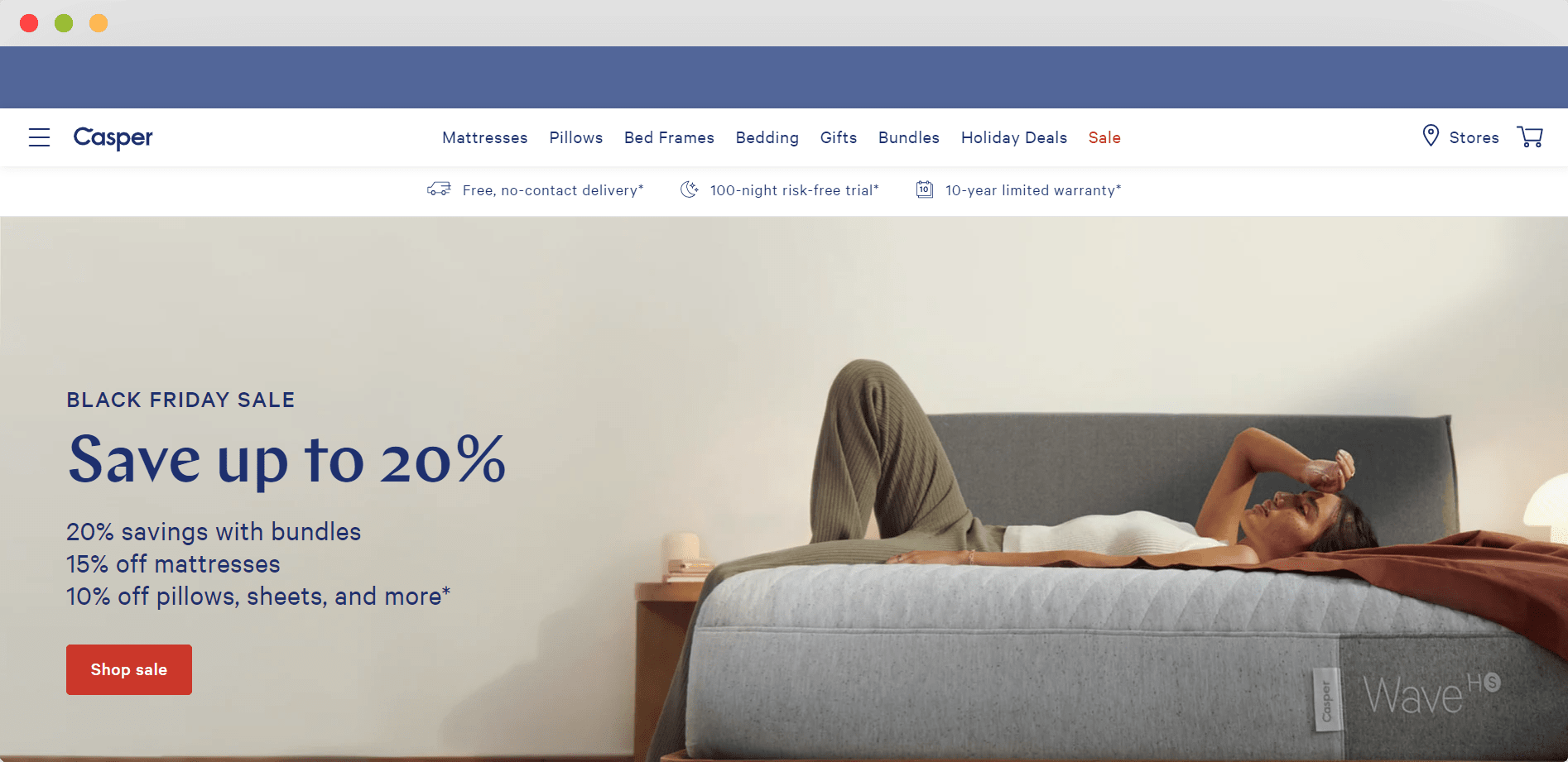There’s a rising marketing strategy that deserves to be noticed for many reasons—it’s the direct-to-consumer or D2C marketing strategy.
Several businesses, like L’Oreal and their new D2C brand Color&Co, have explored this strategy and consumers have been more than happy to see their new venture and interact—about 55% of consumers enjoy directly purchasing from brands.
So, what is Direct-to-Consumer Marketing exactly, and why is it becoming so popular among brands and consumers?
In this guide, we’ll tell you everything you need to know about direct-to-consumer marketing—from its history to becoming a D2C-ready business. If you’re looking to shift to this strategy, better read on.
Let’s get started.

What Is Direct-to-Consumer or D2C Marketing?
Direct-to-consumer (D2C) marketing is a strategy wherein businesses directly sell their product or services to consumers. This means not having to rely on intermediaries to sell their products or services.
Let’s use an example to understand this concept much easier.
Think of companies selling sodas like Coca-cola and Pepsi. For so long, these companies typically sell their products through intermediaries like grocery stores or supermarkets.
Utilizing intermediaries is what we usually know as the business-to-consumer (B2C) business model. Companies have to link with several other companies—like Walmart—to sell their products or services to consumers.
For D2C marketing, businesses won’t need to partner with intermediaries. In most cases, these companies create a website or other popular channels to reach their customers.
From these websites, customers can order products or purchase services directly from that business.
Some popular D2C companies are Glossier and Cards Against Humanity.
History of D2C
Although D2C seems like a product of technology, it’s definitely not a new concept. Even before the internet became a mainstream platform for shopping, brands like Avon were already utilizing such a strategy.
Back in the 15th Century, people in Venice could already order books through the mail and wait for their orders to arrive. That may have taken some time, but stores back then only had to send snail mails to their customers.
Avon also used mail orders to reach their customers. These customers had a catalog, usually in the form of a magazine, that they could use to shop.
When the internet came around, a few businesses tried to implement a D2C strategy but they weren’t successful which led to the trend fizzling out.

It only started to become popular again when brands like Casper, launched in 2014, succeeded.
6 Benefits of D2C Marketing
Despite the success of Casper and other companies using the D2C marketing strategy, many are still skeptical about its benefits.
We can’t deny that going for a less traditional method does introduce some risks. But in this p, we’re here to convince you through the benefits of D2C marketing.
Here are some benefits of D2C marketing:
Provides More Control
Without having to compete with other brands on the shelf, the D2C marketing strategy provides more control in many ways.
First, businesses have more control over their pricing. The absence of intermediaries proves to lower costs typically incurred in partnerships. Lesser expenses mean that companies have room to make their pricing more appealing and competitive for customers.
Another way businesses have more control is through brand messaging. Since products or services are directly being sold to customers, businesses now have more control over how they design their products and create overall branding.
No need to compete for attention when these customers are already scrolling through your website.
Lastly, there’s generally more control over promotions and ways to build customer loyalty. Whether you’ll have a sitewide sale or vouchers given for free, there’s more freedom in enticing your customers to make a purchase.

Direct Access to Customer Data
Another benefit of this marketing strategy is there’s direct access to data, and we don’t mean the private kind.
The type of data you’d have more access to is customer behavior. You’ll easily know what products are frequently bought by whom, and what kinds of products are popular for certain times of the year.
Other essential data that could help in business analytics also become accessible since customers directly interact with your brand.
The more data that you have, the better business decisions you can make.
Builds Customer Loyalty
With this direct interaction, businesses are in a better position to build customer loyalty.
Having direct access to buying behavior allows businesses to establish personas and sales strategies to attract and retain customers.
Customer relationships can also be built through unique, personalized experiences. This is also a great avenue for businesses to improve their customer service, with 70% of consumers choosing to support companies with great customer service.
The more personalized the brand experience, the higher the potential of having a happy customer. And with a company focused on building customer loyalty, it’s definitely possible to grow its customer base.
Potential Higher Margins
It’s common knowledge that middlemen charge a significant amount to their customers. After all, they offer competitive packages that somehow guarantee a bit of profit.
In the D2C strategy, middlemen are taken out of the picture without necessarily losing the potential for higher margins.
This is because companies no longer have to think about fees incurred from the partnership. Without these fees, they can take home more profit from their products or services.

However, don’t forget that several factors come into play when it comes to sales. For as long as the company has a solid marketing strategy and great products or services, profit is almost always guaranteed.
Opportunities to Explore
The absence of intermediaries allows brands to explore opportunities and innovate. They’re not tied down by the need to sell hot items simply because they’re already out of the shelves and directly in front of customers.
For some, this move can be risky. But what is a business venture without risk, right?
Businesses can now explore items that have been in the vault for many years. Small-scale testing can be done to check whether the product is viable or not. And if it does flop, the loss won’t be massive in comparison to traditional scale testing.
Option to Focus on Certain Products
Not all businesses have hundreds of products in their catalog. Startups, for example, usually have just one or a few products they consider to be the best in the market.
Products like these often require a huge amount of effort to advertise because of the risk of being a flop. With the D2C marketing strategy, these companies can easily focus on these products without worrying about diversity early on.
On top of that, lesser fees and more control over the entire selling process helps them test their products and gather data until they’re able to sell the perfect product.
5 Challenges of D2C Marketing
As much as there’s a lot to like about D2C marketing, it still has its own set of challenges—just like any other strategy.
You still need to be creative and innovative, given that businesses are also transitioning to this type of setup. Don’t fret though, these challenges are just merely reminders of what you need to look out for in the long run.
Here are points to ponder on about D2C marketing challenges and ways to overcome these challenges:
Increased Competition
Without a doubt, we can expect an increase in competition over the digital space. As more consumers prefer shopping online, more businesses will vie for their attention and money.

Big companies like Amazon are seen to strengthen their hold over their loyal customers. Ideally, this wouldn’t be a problem if the product or service easily stands out, but those who have yet to find their footing might just lose balance.
Don’t fret though, the best way to overcome this challenge is to strengthen your overall branding and improve customer experience.
Your target market should be able to single you out in a crowd of similar products. Moreover, they should be satisfied with your service to keep coming back.
The more you focus on being remarkable, the better your chances are at leading the D2C race.
Product Differentiation
As mentioned earlier, it’s quite easy to get drowned in a sea of similar products. Thanks to the internet, customers are now taking their time to research and pick which products are actually worth their money.
For the record, it’s not just about the quality of your product or service. It’s also about other things that could entice them to purchase from your store instead of your competition’s.
The problem though is that with similar target markets, businesses often have the same messaging and approach.
A great way to overcome this challenge is by introducing personalization and configuration. It’s indeed a challenge in itself but this paves the path for customers having their unique shopping experience.
From being just one of the brands, you have now become the manufacturer of their dream product.
Buying Habits and Customer Behavior
Social media is one of the biggest influencing factors when it comes to shopping. In a report done by Deloitte, about 29% of consumers purchase products just after scrolling through their social media platforms.
That’s a significant number considering that they make same-day purchases.
On a different note, this suggests that buying habits and customer behavior are easily affected by things on the internet. When a new trend takes over TikTok or Facebook, some company is bound to profit from it.

A way to keep up with their behavior is to keep up with trends—not necessarily all of them. Find ones that resonate with your current branding and find a way to incorporate them into your marketing and brand messaging.
It’s also a great idea to prioritize having great customer service. Not only will your customers appreciate the service, but it’ll also make your brand stand out from the rest.
Investing in great customer service on top of staying relevant and having great products will put you at the top of customers’ minds.
Increased Advertising Expenses
We’ve already mentioned that the competition in the digital space will only become fiercer. This only means that to be seen in your target market’s screens, you need to be ready to spend on advertising.
In 2022, $169 billion will be spent on mobile display ads, most of which were mobile video ad content.
Social media platforms and search engines already know their role in advertising and have priced their services accordingly. And if there’s one thing about advertising on the internet, it’s that you always need to be strategic about it.
For startups and small and medium enterprises, this can be intimidating. Don’t worry though, the way around this is to really identify your target customers and nitpick their habits on the internet.
What do they usually look for? Where do they usually go? These are just two questions that are worth pondering upon.
Fulfillment Logistics
Now that there aren’t any middlemen to handle the sales of these products, brands have to be responsible for finding reliable fulfillment logistics partners to handle their orders.
This is especially relevant for businesses who plan to set up a website for their products.
Remember that once you shift to a D2C ecommerce strategy, you also shift from shipping trucks of products to retailers to shipping orders to individual customers.
The process involves checking orders, sorting out products, and making sure customers actually receive them—a whole new game for many businesses.

New sets of rules, regulations, packaging, and handling come into play. And since products are shipped to individual customers, additional risks and costs are expected.
However, to make this work for you, all you really need is a reliable fulfillment logistics partner. There are several you can find on the internet. Just choose one that can cater to the locations of your target market.
How to Become a D2C-Ready Business
The benefits and challenges have all been laid out, and since you’ve reached this point, you’re probably considering shifting to a D2C strategy.
The only question left is, how?
Below are the different steps to become a D2C-ready business. It’s possible, however, that not all steps apply to you. Just take note of best practices to guide you every step of the way.
Develop a Comprehensive Marketing Plan
All strategies require a comprehensive marketing plan which is why this shouldn’t come as a surprise. However, this step differs now that you need to focus on your selected channels.
You’ll no longer receive help from retailers to advertise your product or pull in foot traffic if you have a brick-and-mortar store.
The marketing plan also has to be creative, innovative, and remarkable to make your product stand out from the crowd. From branding to packaging, everything has to be clear and cohesive to leave an impact on your customers.
Don’t forget to plan your budget, too. Trends change and with a set budget, you’re less likely to overspend and invest in non-essential activities.
Some marketing strategies you can look into include social media marketing, lead generation, and influencer marketing.
A few ps earlier, we’ve mentioned that customers often make same-day purchases after scrolling through social media. That’s why this is a strategy you should definitely explore.

We’re not saying it’s currently the best one for your product, but we are saying that it helps reach a lot of customers and increase the possibility of sales.
Ads on Instagram, YouTube, Facebook, and TikTok all have different advantages and disadvantages. See which platform helps you reach your target customers without breaking the bank.
Lead Generation
Lead generation is a great way to generate new prospects and sales. You have to be consistent in attracting visitors to your store or website.
You shouldn’t stop there though. You should also nurture the leads that you’re getting by listening to their needs and giving them information to convince them to trust your product and your brand.
A common step-by-step to generate and nurture leads start with a great offer, whether a discount or freebie, which leads the customer to an easy sign-up, then recall them through follow-up ads or emails.
Influencer Marketing
A lot of people follow influencers or content creators across different platforms. Because of their content, they’ve generated a significant number of followers who trust their opinions and will definitely listen to their advice.
This is one of the most common ways to advertise products or services these days.
Through content creators, customers can see the quality of the product or service, and their potential experience when they buy or avail of it.
On top of that, these creators always find ways to sneakily advertise your products without being too pushy or deceitful. Given they’re protecting their image, advertising your brand means that it’s worthy of their trust and time.
Train Employees for Customer Service
Traditional strategies put the burden of dealing with customers on retailers. Now that they’re out of the picture, your employees have to be ready to answer questions from customers—both calm and irate.
It’s a great idea to invest in customer service training programs to better prepare your employees for all sorts of situations. If they’re equipped for anything, you can expect your customers to leave your physical store or website happy.

If you do plan on utilizing a website, prioritize setting up a hotline or an actual representative to answer the concerns of customers. Sure, utilizing bots is easier but customers appreciate a real person when airing out their concerns.
Find Reliable Fulfillment Logistics Partners
Sooner or later, your business will expand and you’ll have to start considering opening stores or shipping to other regions.
For those who don’t want to open physical stores due to cost, having your own website can be a cost-effective alternative. But that would entail partnering with a reliable fulfillment logistics partner to ship your products.
If you’ve never shipped products before, you might feel a little bit nervous about this move. However, the right partner will definitely put you at ease.
Remember that your logistics partner won’t just ship your products, they also have to ensure it gets there on time and in one piece—or two.
There are plenty of fulfillment partners all over the globe, some in strategic locations while some offer competitive packages.
NicheDropshipping has a fulfillment center service that includes warehousing, labeling, quality checking, and shipping. Truly a fuss-free process for those who need the extra help.
Establish A Loyalty Program
Although we’ve clearly stated that D2C helps build customer loyalty, some kind of effort still needs to be put into establishing loyalty programs to entice customers to make repurchases.
With that, develop a loyalty program that appeals to your target customers. Whether it’s offering discounts or giving freebies for a minimum amount, make sure that it’s effective and enticing.

An established loyalty program has been seen to positively increase a company’s reputation by 73%. On top of that, loyal customers are also repeated customers which also means an increase in profit. Don’t just stop at developing it, also set in place mechanisms that will maintain it. Whether you have a year-long plan for sales and discounts or have a dedicated resource, just make sure it won’t introduce more expense than profit.
Invest in a CRM Software
Given that one of the benefits of D2C is direct access to customer data, you would need customer relationship management (CRM) software to manage interactions with customers.
This software will not just gather and use data, but it will create effective engagement with customers.
CRM software is a system that business owners can use to establish and develop relationships with their customers. This is done through efficient processes, organization, and time management.
Although CRM software has only gained traction recently, it was already being utilized back in the 1990s.
With a CRM system, you can store customer contact information legally, find sales opportunities, manage marketing and sales campaigns, and record product or service issues in just one place.
Moreover, most CRM systems allow you to customize your dashboard and see everything you want to. From order status to pending issues, you can set up the perfect dashboard for easy access.
This centralized data location makes it easier to make informed decisions and manage several parts of your business. Ideally, small and medium enterprises would definitely benefit from this kind of investment.
Choose the Best Channel
It can be tempting to explore all channels available now that there are no intermediaries. However, this may not be the smartest move if you’re up against established brands.
You still need to identify which channels best reach your customers directly.
With that said, choose the best channel for your business. Do your research and don’t just put up a website or a brick-and-mortar store without data to back you up.

The same goes for choosing social media platforms to advertise in. Just because TikTok has over a billion users, doesn’t automatically mean it’s the best place to advertise your product.
You also shouldn’t open a physical store in the most popular area in the city just because it has lots of foot traffic.
Gather data, interpret it, and make informed decisions from it for better business outcomes.
Key Takeaways
D2C marketing is indeed deserving of the popularity and traction it’s getting. The benefits of this strategy are worth considering despite having a couple of challenges.
If you’re still undecided to transition to this strategy, look at the current status of your business and see where your target market is at. Don’t just rely on what is popular because sometimes it’s not always the best option.
Moreover, don’t be afraid to explore offline channels. The internet may be popular, but it’s not necessarily the best channel for all products.
Being a D2C brand—or becoming one—requires a lot of effort and research. Should you need to partner with a reliable fulfillment center or help to start your business, feel free to contact us to discuss our services.

